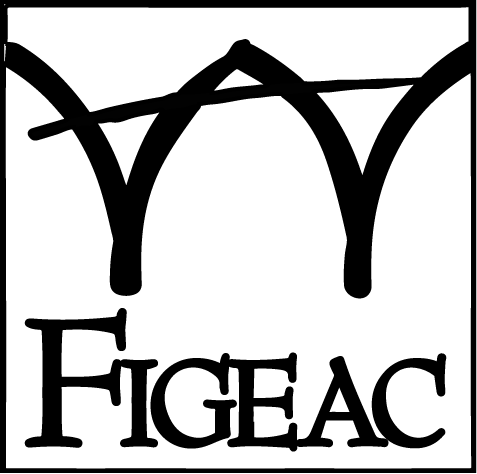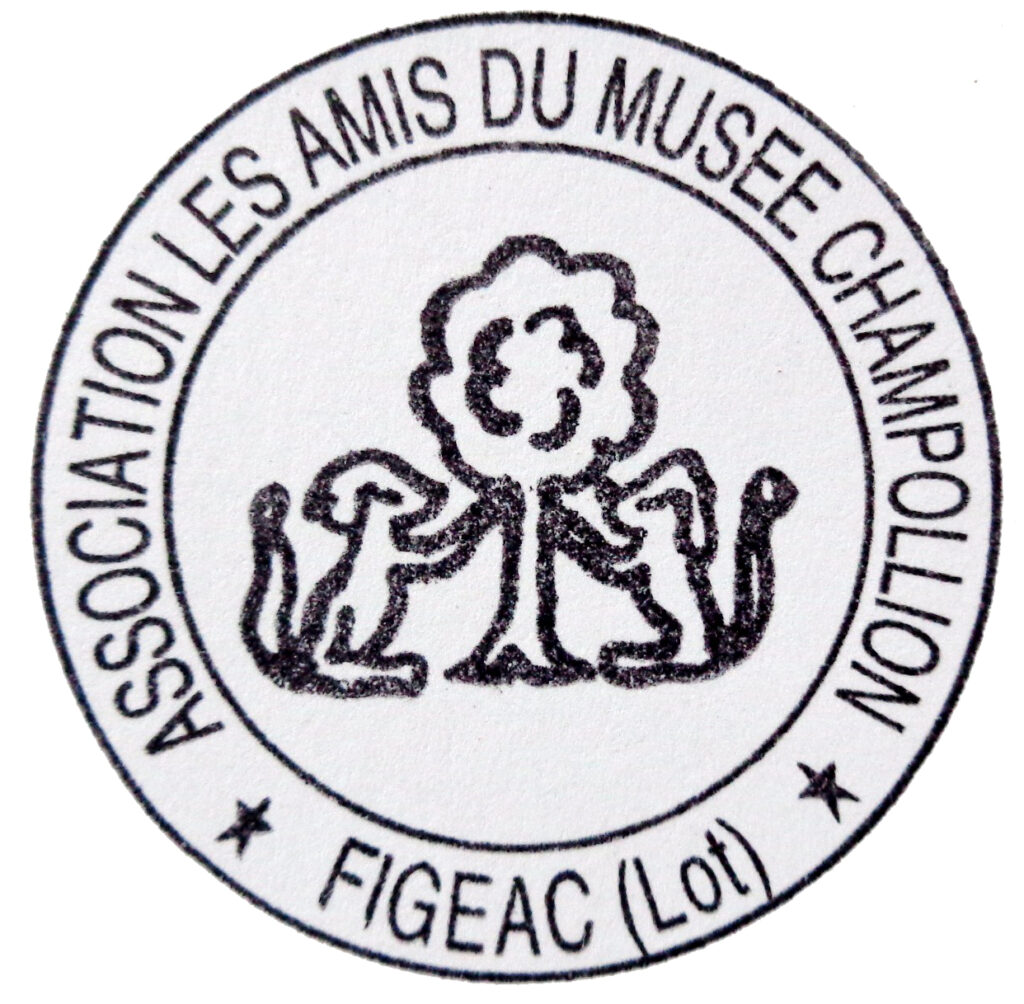Collections
Champollion and Egypt
Jean-François Champollion succeeded in deciphering the Egyptian hieroglyphics after many years of study. His task is conjured up through extracts of letters he exchanged regularly with his brother and the notes jotted down as the intuitions of a genius enabled him to find his way round so many difficulties. He set up the first scientific expedition to the Nile Valley in 1828, bringing back thousands of documents written by the architects, painters and artists who accompanied him. This first room illustrates the religious beliefs of the ancient Egyptians : a collection of divinities greets the visitor while the funeral rituals are illustrated around the mummy.
Mankind, the world and the written word
How were the first signs written? What were the consequences of this fabulous invention? Are there still writing systems waiting to be deciphered? Documents from around the world, interactive touchpads and the shapes of enigmatic scripts incite the visitor to search for the reasons and signification behind the act of writing.
The Invention of the alphabets around the Mediterranean
The earliest alphabets appeared on the eastern shores of the Mediterranean during the 2nd millennium BC. It took less than a thousand years for dozens of different alphabets to come into being in the Middle East; the Phoenician alphabet being perhaps the best known. A writing system that uses a limited number of symbols was a true revolution. Four scripts still in use today are directly derived from the Phoenician : Hebrew, Arab, Greek and Latin.
The book, a tangible memory
The book appeared in Europe at the beginning of our era and over twenty centuries has seen a number of technological transformations : the production of paper, which replaced parchment, the invention of the printing press, the revolution of digital technology…
Writing, government and the citizen
Official deeds, administrative forms, newspapers, grievances as well as private correspondence illustrate the use of writing as a means of control by administration but also the possibility to stay informed, to voice one’s opinion, protest, and create…
Video room
Three screens are available for visitors to view a number of documents illustrating the written word in a comfortable area you will come to at the end of your visit. Documents include the medical team’s 3D restitution of the mummy, and links to the internet sites of the Bibliothèque Nationale de France, the Louvre Museum, as well as the Shanghai Museum. From the loggia, the view over Place Champollion is breathtaking.
The earliest scripts
Cuneiform script
The earliest script to appear around 3500 BC was in Mesopotamia on tablets inscribed with details of administration and the exchange of goods : delivery notes, sales contracts, lease of land, salary lists… Cuneiform script was also the medium for transcribing the oldest mythological tales and the first civil codes.
Egyptian hieroglyphics
Settlements grew up along the banks of the Nile, cultivating the land fertilized each year by the Nile floods. Towards the end of the 4th century BC a strong, stable political system was in place under the authority of a king, and a genuine script was adopted around 3200 BC : the Egyptians painted, drew and engraved hieroglyphs in order to perpetuate their existence.
Chinese script
The oldest Chinese characters, jiaguwen, are divinatory protocols with which communication was made possible with the gods and royal ancestors. They evolved around the 14th century BC. Chinese script, the only original form of writing still in use today, produced the art of calligraphy, which the Chinese place above painting.
Maya glyphs
Maya glyphs are one of the systems used in Central America. The Maya civilization was at its height during the 3rd to the 9th centuries AD when vast cities were built, some of which can still be visited today. With the arrival of the Spanish in the 16th century, their script became obscure until it was totally abandoned in the 17th century. Today, the Maya glyphs are slowly revealing their secrets as deciphering progresses.
Outside the museum walls
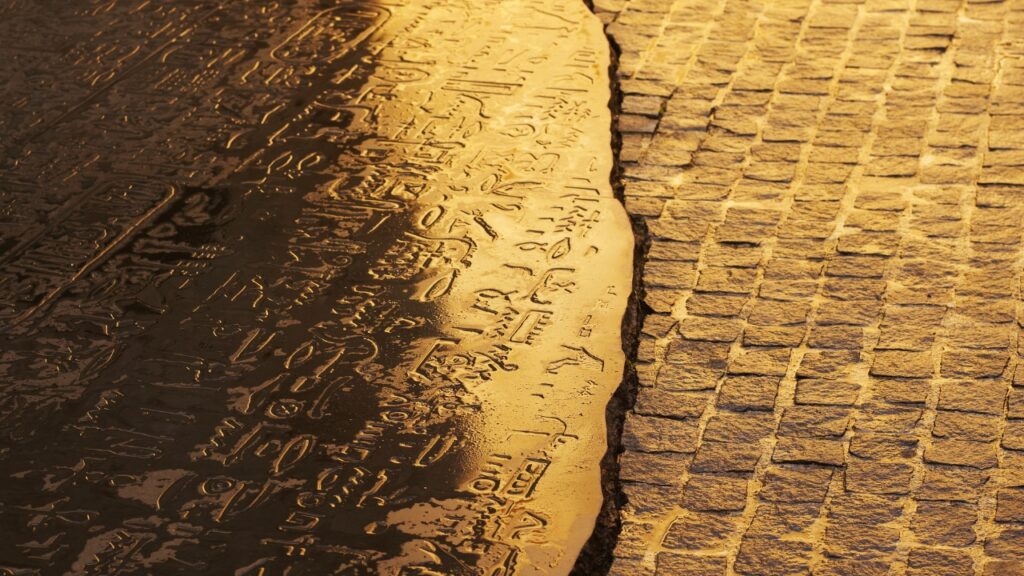
The artist Joseph Kosuth designed the Place des Écritures – Ex Libris J-F Champollion (Figeac).
It was created in 1990, commissioned by the Ministry of Culture and Communication and the town of Figeac for the bicentenary of the birth of Champollion.
Behind the house where Champollion was born, Joseph Kosuth placed his creation : a huge slab of black granite which is an exact enlarged reproduction of the Rosetta Stone (11 x 8 m). The translation of the text of a decree of Ptolemy V Epiphane is engraved on the glass door of an adjacent vaulted cellar. Terraced gardens evoking the land of the pharaohs, planted with papyrus, tamarisk, and Mediterranean essences, overlook the area.
Joseph Kosuth’s Rosetta Stone fits into the architecture of the medieval town just as the writing on the stone is intimately linked with language and geography. The three scripts : hieroglyphic, demotic, and Greek expressing two languages, are placed at ground level and shed an unusual light on the signification of words and language, a subject at the heart of Kosuth’s work.
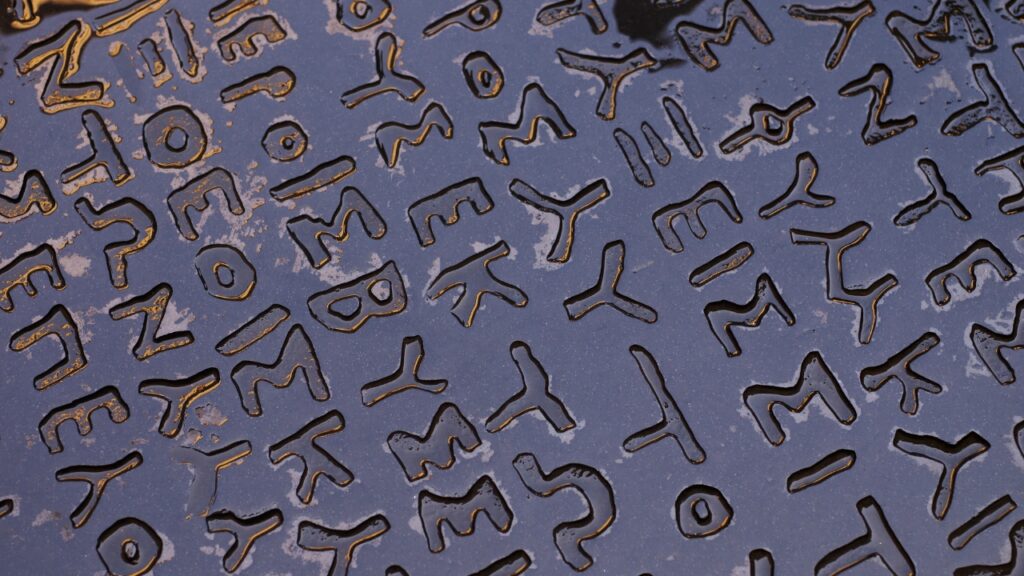
Pioneer of conceptual art and artistic installations, Joseph Kosuth started in the sixties to produce work based on language; setting up installations for different approaches to art. His works invariably explore the role and meaning of language.
In the course of 30 years, his study of art and language had led to several installations, public commissions and publications in Europe, the USA and the Far East. He has been present at five Documenta and four Venice Biennales where his work was shown in the Hungarian pavilion (1993).
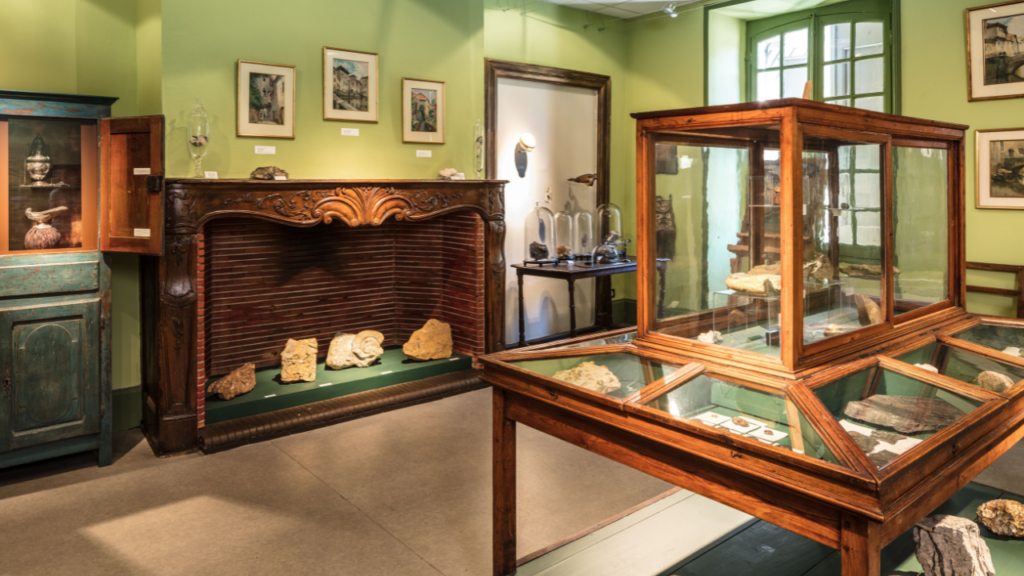
The Museum of History, adjacent to the recently renovated reception rooms of the Seminary, exhibits physical elements relating to the history of the town and the surrounding area, as well as artefacts brought back from their travels by various donors. It illustrates the spirit of a collector of curiosities ranging from paintings by the artist Pierre Daura, and presidential gifts to Georges Pompidou (a carved elephant tusk and Moroccan fantasia saddles) to weapons, natural history, minerals, fossils, and prehistoric tools. A portrait of the founder of the Seminary Antoine de Laborie and furniture from the sacristy of the church Notre Dame du Puy are reminders of the 17th century in Figeac.
Practical information
Courtyard of Le Puy Church, access via rue Victor Delbos.
Opening times: July and August daily from 2:30 pm to 6:30 pm.
Groups by appointment, contact Musée Champollion at +33 (0)5 65 59 31 08.
Guided tour: 7th July to 1st September – Sundays at 10:30 am (1h30m).
Other times: open on request, contact Musée Champollion at +33 (0)5 65 50 31 08.
A museum in keeping with the town
Figeac, « Grand Site de Midi-Pyrénées » and « Ville d’Art et d’Histoire »
Figeac’s situation between Auvergne and Quercy explains the exceptional development of the town during the Middle Ages. Taking advantage of the commercial thoroughfares crossing the south of France, the town, a halt on the Way of St. James, prospered thanks to the fortunes of its inhabitants. The historic centre still reveals the homes and urban palaces belonging to the businessmen of the 13th and 14th centuries. More than just the open lofts « solelho » and Renaissance galleries, the evolution of the sandstone architecture between the 12th and 19th centuries can be retraced thanks to the beautifully decorated facades which place it alongside other medieval treasures such as Cluny and Cordes.
The label « Ville d’Art et d’Histoire » was awarded to the town in 1991 by the Ministry of Culture and Communication and the designation « Grand Site Midi-Pyrénées » rewards the town’s policy of conservation which includes works of contemporary architects such as Kosuth’s Place des Écritures and Marc Mimram’s footbridge crossing the Célé river.
The origin of the Museum – Home of the Champollion family
In 1977 the town council, backed by the majority of the town’s population, decided to renovate the house where Champollion was born and transform it into a museum dedicated to the illustrious decipherer of hieroglyphics. The Champollion Museum was opened in December 1986 by President François Mitterrand.
This was only the first stage in an ambitious plan that was continued in 1994 when the neighbouring building was bought by the town in order to triple the capacity of the museum.
The objective of the museum was now to add to the collections giving pride of place to Jean-François Champollion in the development of the history of writing.
The new museum « Champollion – Les écritures du monde » opened its doors to the public in 2007.
Renovation within a protected sector
The architects Moatti & Rivière were entrusted with the renovation of the museum.
The dual façade of the building is emblematic of the originality of the project : the medieval stone façade is lined with a second façade made of glass and a copper sheet cut out with characters from scripts around the world. The graphic designer Pierre di Sciullo drew the characters of this “façade of a thousand letters”.
The installations of the permanent collection in the museum were designed by Pascal Payeur.
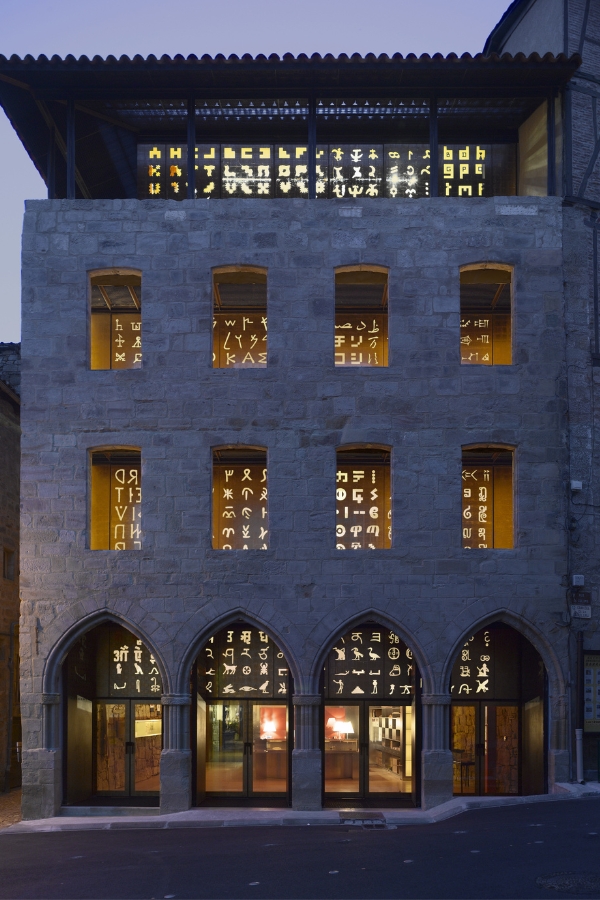

Jean François Champollion, the decipherer of Egyptian hieroglyphics, was born in Figeac in 1790
Jacques Champollion, a travelling salesman from the Dauphiné region, arrived in Figeac around 1770. He opened a bookshop and married a local girl. It is not difficult to imagine the young Jean François sitting in his father’s shop reading the “Courrier d’Egypte, at a time when the French Revolution had closed down the schools run by the churches. At the age of 10 Jean François left Figeac for Grenoble with his elder brother Jacques Joseph who was to oversee his education. His passion for ancient history led him, with his brother’s approval, to study the ancient languages and their scripts.
He was only 17 years old when he undertook his studies at the Collège de France and the Ecole des Langues Orientales in Paris. He studied the text of the Rosetta stone and went through hundreds of documents, each time confronted with the stumbling block of the nature of the signs used in the three Egyptian scripts. His perseverance in a matter where hypothesis, doubt and strokes of genius were constant companions was rewarded when he declared on 14th September 1822 “je tiens l’affaire” (I’ve got it!). He had understood that Egyptian hieroglyphics were based on a complex system of “a mixture of figurative, symbolic and phonetic symbols”.
“I’ve got it!”
Although some called him a charlatan, Jean François Champollion was admired by many. Wilhelm von Humboldt “ it is wonderful, one of the most remarkable discoveries made in his time”. The future king Louis–Philippe “ (this) brilliant discovery (…) is an honour not only for the scholar but also for the nation.”
A great adventure
The oldest graphic inscriptions go back some 50,000 years. However, it was only 5,300 years ago that mankind transposed his thoughts into signs that fixed his words, enabling him to communicate in a permanent fashion with his fellow beings. The invention of script is threefold: intellectual, political and social. The consequences are immense: writing enables mankind to have a privileged relationship with the gods, knowledge of the surrounding world; it gives power to control, enables the transmission of knowledge, and the exchange of goods. In more recent times, writing has allowed the individual to obtain information, express their ideas, their feelings.
The Museum of Writing takes the visitor on a journey following Champollion’s footsteps that gives them the opportunity to take part in the adventure of the written word and consider its place in our future world.
